What’s The Best Material For A Projector Screen? (Guide)
What’s The Best Material For A Projector Screen? (Guide)
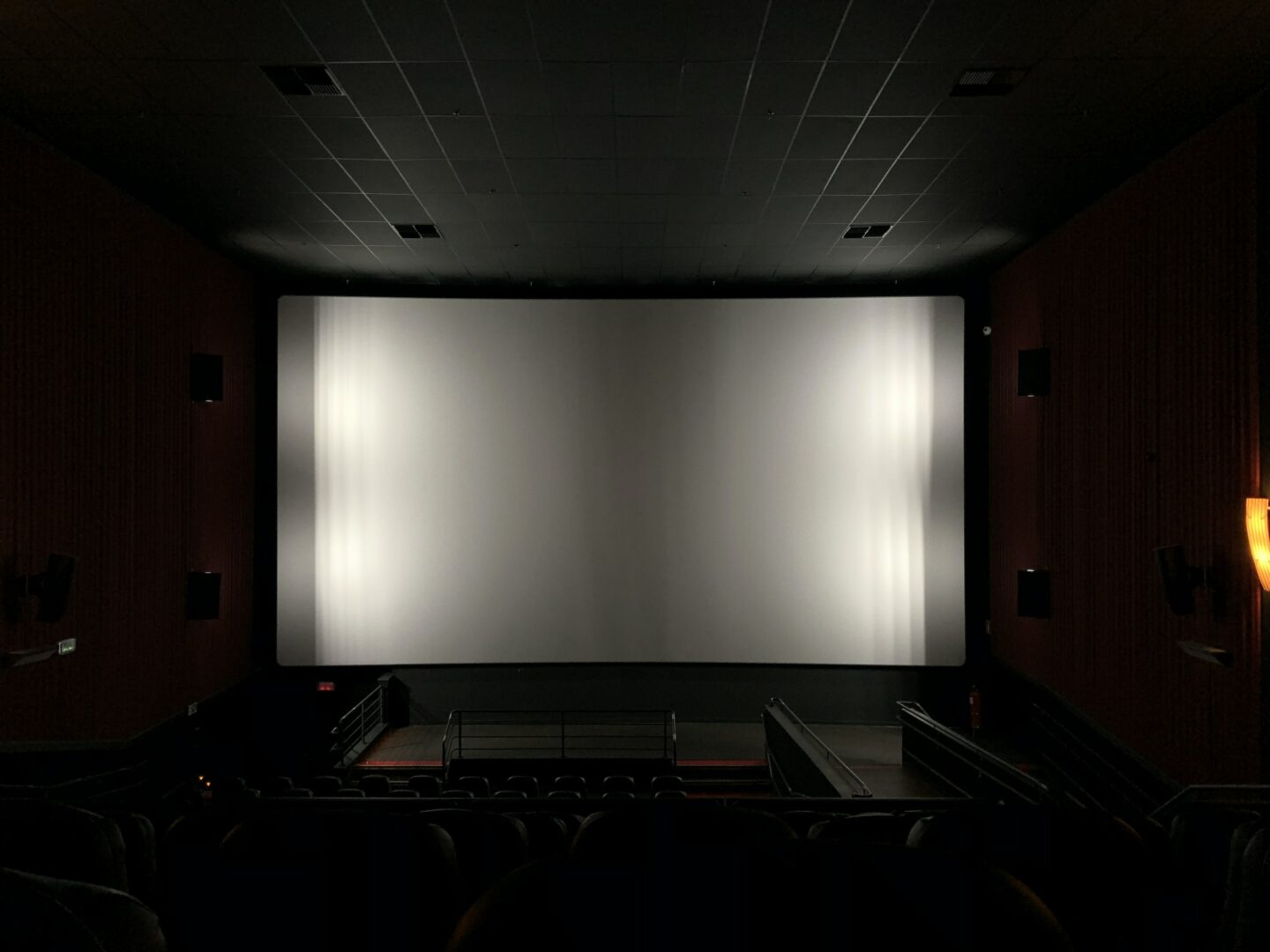
Have you ever wondered what makes the images on the big screen so clear and realistic?
It’s the quality of the projector screen.
Besides room lighting, the material of the projector’s screen has a direct influence on the picture quality you experience.
The better quality the material of the projector screen is, the clearer the overall image quality will be.
So today we’ll be taking a look at the various materials that make up these screens, and seeing which is the best for watching your favorite content!
What Is The Best Material For A Projector Screen?
White blackout cloth is the best projector screen material in my opinion as it absorbs light, has the same benefits of a white screen by enhancing white levels, and is useable in darker rooms. It’s a mix of PVC, cotton, and/or polyester coated in multiple layers of foam.
Check Yandood Projector Screen Material Fabric Availability
What Aspects Influence Which Projector Screen Materials Work Best?
Projector Type & Its Capability
One of the biggest aspects determining what screen material to use is the type of projector that’s also being used.
There’s many different projector types, such as: short throw, DLP, LCD, LED, and laser projectors.
However some of those may be better suited for some materials than others.
The capabilities of that device also influences the material to pick since it’ll directly affect picture quality.
While a brighter projector can work with both lighter and darker screens, a dimmer projector may work better with lighter screens in some scenarios; depending on other factors.
For example, if you used a high-nit laser projector, which uses a laser light source to produce an image, it would work with a majority of projector screen materials.
But if you used a projector that had a dimmer internal lamp, then thicker materials with a higher gain like white PVC fabric would probably help retain a brighter image.
Here’s some of the best ones in my opinion.
https://easyhometheater.net/the-best-home-theater-projectors
Room Lighting That The Projector Is In
The lighting of the room is also something to consider when choosing the right screen material.
Ideally you want as little light as possible in the room for optimal image quality.
From my experience, if the room has a lot of light, whether it’s from sunlight or lights in the room, materials with ambient light rejection properties tend to work best for projector screens.
This material basically helps dissipate visible light on screen for an overall clearer image.
For darker rooms though, screen materials with a higher contrast and darker color can give the image more depth with black levels.
The Gain
The gain of the material of the projector screen is important since it affects how things on screen look.
To put it simply, gain is basically how reflective the screen is with light that hits it.
The higher the gain, the higher the contrast ratio (the difference between darker and lighter elements on screen)
The tradeoff is that the higher gain limits the viewing angle and visibility of the screen when seated off angle.
Whereas lower gain materials will have a lower contrast ratio, but will have a higher visibility and uniformity off angle.
The Viewing Angle
I already mentioned this, but the viewing angle is something you’ll want to be aware of when choosing the right material.
If your seating position is more off angle, then higher gain and lighter colored materials may work better.
But if you’re seated in the center then there’s a little more versatility with suitable materials.
The Color Accuracy Of The Screen
Different materials have different levels of color accuracy which is important for a more realistic image.
But things like ambient lighting in the room, the capability of the projector, and even viewing angles can also shift how these colors look on screen.
So properly adjusting for all of these factors, whether it’s with the projector’s color settings itself, or the room’s lighting, can provide for a better viewing experience.
How Durable The Projector Screen Is
If you plan on having a projector setup outside, then that screen’s durability is something you’ll want to be mindful of.
If it’s a painted surface that’s acting as the projection surface, then use specialized paint that’s made to also last outdoors.
Also ensure that the surface itself is smooth and not an uneven texture as this can distort the image.
For physical outdoor screens, opt for materials with water proof capabilities, resistance to heat & cold, aren’t prone tearing, aren’t difficult to clean, and have good visibility with sun light.
The Size Of The Projector Screen
Lastly the size of the viewable screen is important when choosing which material to use.
The bigger the room, and the further from the screen you’re seated, the bigger the screen needs to be to remain visible.
And the bigger that screen, the firmer the material of that screen needs to be to remain uniform throughout.
That’s why smaller projection screens can be more forgiving in that aspect, since it becomes easier to spot imperfections in the image with larger screens.
Then there’s things to consider like the aspect ratio of the screen and the main seating location since these factors affect the shape, width, and height of the screen; as well as the optimal viewing distance & angle for viewers.
What Materials Can Projector Screens Be Made Of?
Projector screens can actually be made of many types of materials & types that includes tension projector screens, fiberglass, textile, paint variants, etc.
There can even be some crossover between types.
So let’s take a look at some of the most common ones, as well as which one is best.
Acoustically Transparent Screens
Acoustically transparent screens are basically a type of screen that allows sound to pass through without light also doing so.
This in turn gives a better picture quality and better sound quality without those speakers being visible.
There are 2 types of acoustically transparent screens, perforated and woven.
Perforated Screens
Perforated screens, like the name suggests, are screens with a number of tiny holes invisible to the human eye, designed to let sound waves pass through it.
It can be made of any number of materials but the most common is PVC.
You’ll sometimes see these used in movie theaters with speakers mounted behind them to improve spatial imaging and immersion.
If a PVC or perforated screen is generally subpar in quality, you could experience any number of visual artifacts, discoloring, and even loss in sharpness.
Woven Screens
Woven is the other type of acoustically transparent screen where a special pattern also allows sound to pass through it.
Similar visual issues to perforated screens can also sometimes be seen in lower grade ones that include double imaging, the moire effect, and subpar color accuracy.
In terms of which is better out of these 2, it’s tough to say because there’s so many different versions of them.
However, both can both work well in the right visual conditions.
Silver Screens
Silver projector screens are some of the oldest, and were basically made with the intentions of being used in a dark room so that it was sufficiently able to augment the light it received for the resulting image.
Unlike grey screens, silver ones have a higher gain value; making them more reflective by nature.
This allows them to enhance white tones in the image for a better contrast, which can help the vibrancy of the image.
Newer ones have made a number of advances when it comes to black levels and color radiance, making them a solid option.
Grey Screens
Grey screens are basically a matte version of the silver screen — with a lower gain value that allows them to absorb more light.
This makes them suitable for brighter and darker environments.
They also have the unique benefits of better viewing angles and white levels for content.
Dark Blackout Cloth Screens
Dark blackout cloth screens are really dark screens made with the intention of improving black levels.
These types of screens are used with projectors that are high powered but typically aren’t used as much as white blackout variants due to the darker picture it may produce.
Painted Projector Screens
When considering the better looking option between a projector screen vs a wall, it can be tricky since there’s quite a few variables that can affect this.
But if you are going to use a wall, you also have the option of using projector paint.
This is a paint specifically made with the purpose of being used with a projector and a surface for a quality looking image.
In this case, you’ll want to make sure the surface you use is somewhat flat in texture, and is the right color for your specific environment.
This should help in that case.
https://easyhometheater.net/does-the-color-of-the-wall-matter-for-a-projector
The Color Of The Projector Screen Material Also Matters When Deciding

Before actually getting into the best material for a projector screen, I felt it was necessary to first ascertain what the best color was first.
That’s because the color of the material also plays a substantial role in the resulting picture quality.
When choosing, there’s typically slight variations of 3 main colors you’ll come across; grey, black, and white.
Each have their own advantages and disadvantages so let’s quickly cover them to see which color works the best when it comes to projector screen installation.
White
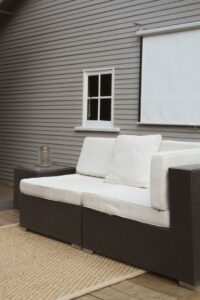
White projector screens were actually the first of their kind, having been the standard choice in cinema for a while.
This is because white screens tends to reflect light due to their high gain, allowing to output brighter white levels.
However the problem with these types of screens also stems from their reflectivity.
If the room has any kind of direct sunlight or bright lighting, the screen can reflect that light which can make it hard to see.
Black levels in content can sometimes be elevated with white screens due to the fact that black is the absence of light, and white is the exact opposite — making it hard for it to produce as deep black levels.
Though there are some projectors that can account for usage with a white screen and compensate by making adjustments so that’s definitely something to note.
White screens also sometimes have issues with viewing angles so people sitting off to the sides will might experience a degradation in picture quality.
This is why it’s often recommended that white screens be used in darker settings so that they don’t reflect whatever light might be present in the room.
This is unless you’re using white blackout cloth screens of course; in which case they’ll have the advantages of all 3.
Grey
Grey screens are slightly newer and can be thought of as offering the best of both worlds of both white and black.
While it won’t surpasses white in brightness, or black in color reproduction, it’s still a solid compromise between the 2 in my opinion.
Grey screens can be used in bright and dark environments since it absorbs some of the light, and reflects the other portion.
This improves its contrast ratio when compared with white screens, allowing for deeper black levels.
While grey screens can sometimes portray whiter tones as grey in content, a more powerful projector or lighter screen can help in that regard.
Black
Black screens are a newer color when it comes to screens and are often lauded for their sharp picture quality and accurate color reproduction.
Since black absorbs all light, they can be used in brighter rooms without worry of reflecting light which can also help with viewing angles.
This allows colors on screen to appear much more vibrant, while exhibiting much darker black levels.
However black screens can sometimes have dull white levels if the projector it’s used with isn’t that bright in terms of luminosity.
Now in terms of which is better out of these, I would say that black screens are probably best in terms of vibrancy though white might produce a brighter image.
But for a more well rounded screen that works in a variety of viewing conditions, grey screens are likely best in that case.
The Best Projector Screen Material Is White Blackout Cloth
Remember our original question of what the best projector screen material was?
Undoubtedly, in my opinion, white blackout cloth screens are the best material to use for a projection screen.
While silver and grey screens can be a close second in some instances, white black out cloth is best in terms of its versatility.
Typically matte white in color, this durable material, conventionally made of a combination of PVC, cotton, and/or polyester — is coated in multiple layers of black & white foam that’s designed to not let light pass through it.
This makes it an especially viable choice in areas with lots of ambient light.
Rather than reflecting light like a typical white screen would, it absorbs it.
However, because it still has the benefits that a white screen would with higher white levels, it can also be used in darker rooms making it an extremely versatile option.
Check Yandood Projector Screen Material Fabric Availability
Will A White Sheet Work As A Projector Screen?
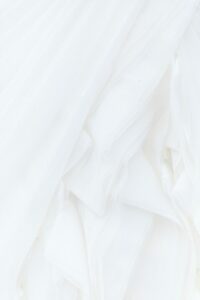
Yes you technically can use a white sheet as a projector screen, though you’ll want to make sure the sheet itself remains tout and doesn’t wrinkle or bunch up.
Additionally, because the material may not be as thick, you may have to put something behind it to prevent light bleed and maintain a good picture quality for your content.
Though ideally, using a screen or paint is probably the better option.
Can I Use Polyester For A Projector Screen
You can also use a fabric made of polyester with your projector, however the problem with this is it can sometimes crease which can affect the image.
A polyester blend is a better choice since it’ll allow the material to stretch, making the entire surface of the screen uniform.
Can You Use Drop Cloth For A Projector Screen?
Drop cloth can be used for a projector screen as well, especially if it’s made of a thicker canvas like material.
Just keep in mind that the color will dictate what environment suits the screen best.
Best Projector Screen Material For 4K

What if you wanted to watch 4K material, what would the best screen material be in that case?
Well similar to my earlier recommendation, I’d definitely have to say white blackout cloth would be the most suitable for 4K content as it’d allow for the most crisp and dynamic image quality.
Will A Tarp Work For A Movie Screen?
If you didn’t have a dedicated movie screen, could you just use a tarp?
Although you technically could use a tarp for a projection screen, I really wouldn’t advise since its flexibility and wrinkles could cause the picture quality to be uneven and distracting.
What Is The Best Material For An Outdoor Movie Screen?
In terms of outdoor movie screens, the best materials would be some sort of outdoor fabric, canvas like material, or even an inflatable screen.
There’s lots of options though, and the best in those cases would depend on the amount of sunlight, viewing conditions, viewing angles, and seating arrangements.
Final Thoughts
Well that about wraps it for this one.
In short, the best material for a projector screen in my opinion is white blackout cloth since it absorbs light while also maintaining a bright and vivid image — making it the ideal surface to project onto.
Though it depends on your individual viewing environment, blackout cloth tends to look best from my experience.
You can also make your projector brighter through various ways.
Hopefully this helps though and if you have any questions, leave a comment below.
Until next time, make it easy, keep it simple.
About Me
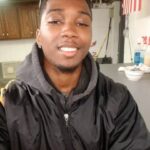
Jay
Hey everyone it’s nice to meet you. I'm Jay, writer & founder of the site Easy Home Theater. I've been with this hobby of home entertainment for many years now. I decided to create this site to be a helpful resource, and share everything that I've learned from personal experience with you. I also happen to be a huge gamer, lover of all things tech related, and a major fitness buff (love weightlifting)
Contact: Contact Jay
Facebook: https://www.facebook.com/Easyhometheater/
X: https://x.com/easyhometheater
Pinterest: https://www.pinterest.com/easyhometheater/pins/
Instagram: https://www.instagram.com/easyhometheater/
Followit: https://follow.it/easy-home-theater
Bluesky: https://bsky.app/profile/easyhometheater.bsky.social




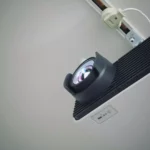


Leave a Reply